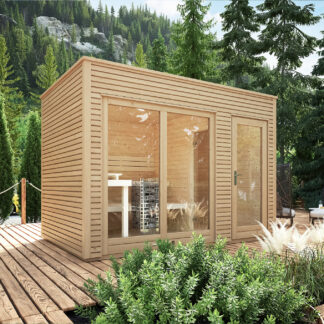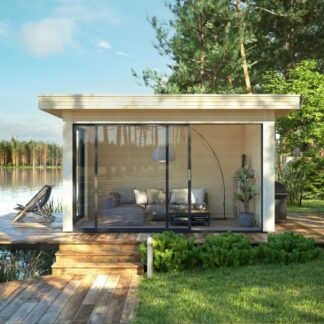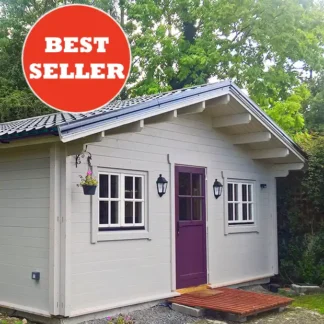It’s the cosiness, the warmth and comfort, that is the enduring image of a log cabin. But the big question is, how true is the image? Are they really that warm and comfortable? And how much does it cost to keep them warm?
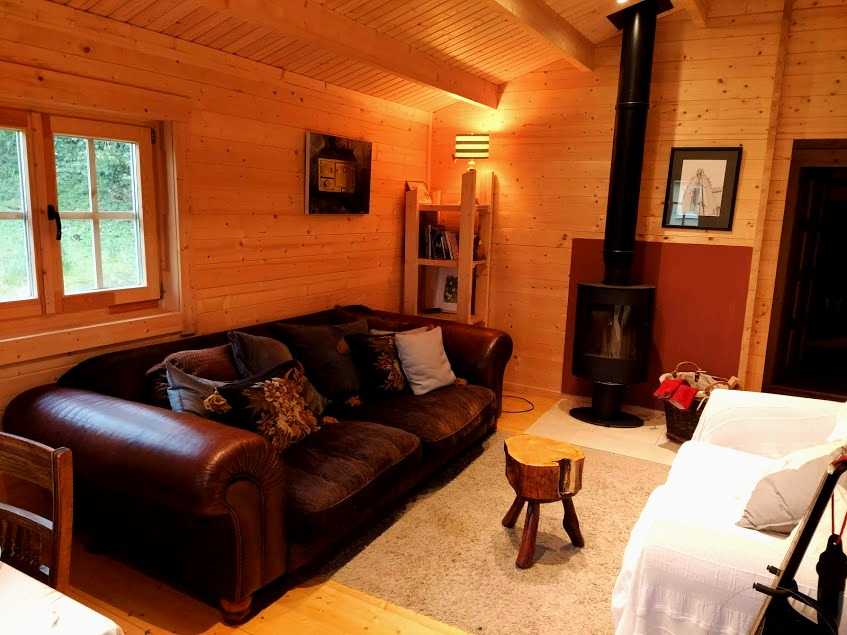
Cozy, comfortable log cabins
Are log cabins warm?
Log cabins can be wonderfully arm and cozy, and reasonably cheap to heat. It is all about how the log cabin is constructed.
Like any building, the insulating value of the walls, roof and floors decide how warm the building will be, and how easy it is to heat. Think about it – if you’re lying in bed on a cold winter’s morning with only a sheet covering you, you’re going to be cold no matter what the sheet is made of.
So, in your log cabin, you need a wall thickness of more than 6 inches (150 millimetres) if you want a log cabin that is warm and coy in the winter months.
Some companies offer log cabins with only a 3 inch (75 millimetre) thick timber wall, and if you by one of these, you’re going to have a cold, cold log cabin. Brrrrr! (You will also have a damp log cabin, with black spots on the walls and quite possibly water coming through. So don’t buy a cabin with 3 inch thick walls.)
What are the best log cabin walls
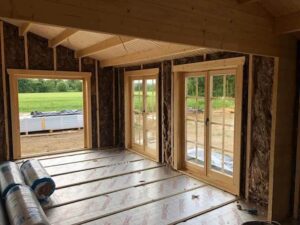
Are log cabins easy to heat?
At Timberliving, we offer double Leaf walls. Our standard build is a 45mm outside wall with 100mm cavity and a 30mm inside wall. This gives you plenty of insulation, as well as a very strong internal wall from which you can hang kitchen presses and anything else of significant weight.
Do log cabins need to be insulated?
You could easily argue that you do not need to have insulation in your log cabin walls, but that would be true only if your log cabin walls are solid wood and a minimum of 8 inches (200 millimetres) thickness. But this class of a log home is very expensive to buy and build.
If you’re planning on using your log cabin for sleeping in, especially during the winter, you will need to insulate your walls. We build our cabins with a standard four inch (100 millimetre) cavity, and use a product called METAC, which is a high grade, quality thermal insulation, as insulation within the cavity.
And the wall insulation does more than just help keep the heat in. Wall insulation also ensures that there is no mould within the cabin itself. If your cabin is built without wall insulation, and is being regularly heated on very cold winter nights, you can expect mould, in certain situations. Mould is generated when moist, warm air touches cold surfaces and condenses. Take a situation in a single wall, uninsulated cabin, with (say) outside temperatures of 2 degrees, and a stove heating the cabin inside. The surfaces of the walls will be warm, EXCEPT behind wardrobes and presses, because it will be difficult for the warmth to get behind these fittings. So, you will have damp air connecting with these cold surfaces. The dampness in this air condenses on the cold surfaces, encouraging the growth of mould. NOT a pretty picture…
Increasing your log cabin insulation levels
If you are going for planning, you will need greater insulation in the walls and roof of your cabin. Wall insulation thickness can be increased either by increasing the size of the cavity, or using external insulation full stop this has the benefit, from a planning point of view, you of having a cement board finish, which is often a requirement of planning applications.
Log cabin wall thickness and noise proofing
One of the benefits of our double Leaf walls is the noise insulation they provide. Come to one of our showrooms and here for yourself how quiet it is inside a timber living log cabin. Whether you are looking for a residential log cabin , a granny flat one bedroom log cabin, or if you have your own bespoke design log cabin we can provide you with the insulation levels you require.
Are log cabins easy to heat?
Of course, if you have a well insulated log cabin, there will be a smaller heat requirement. And the smaller the heat requirement, the easier, and CHEAPER! it will be to heat. And that means a number of benefits to you, the user. The ongoing savings made with less fuel buying is great, but it also means that the hardware you buy will be cheaper too. A smaller stove, for instance, is going to cost a lot less than a stove twice its size. You can expect a few hundred euro on your hardware cost if your cabin is well insulated. And then there’s the fuel handling, especially if you’re using a solid fuel stove or boiler. That means carrying is and less ashing out too!
What heating system can I use in my log cabin
You can use any form of heating system in your log cabin: solid fuel, wood pellet, back boiler with rads, oil or gas, or even heat pumps and/or underfloor heating. Whatever heating system you use, your heating requirement and bills will be very much reduced as you increase your insulation. We have a blog post about heating your log cabin – take a read here: Heating a Log Cabin
Why not come and visit us at our showrooms in Boyle (086 817 0429), Tullow (05991 81039) or Carrigaline (087 6464 280) and see for yourself the quality of our log cabins.

